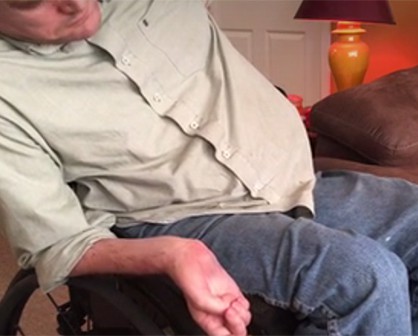
When it comes to full-time wheelchair use, the one aspect we all have in common is pressure management. There’s a misguided notion that some of us are at risk of pressure sores (decubitus ulcers), while others of us are not. The fact is, full-time wheelers are all at risk for pressure sores. Approximately 75 percent of our body weight is concentrated on our buttocks when seated — a region that isn’t physiologically designed to sustain that static weight for extended periods. As a result, we all have to routinely adjust positioning to reduce concentrated pressure in order to lower our risks of pressure sores.
For low-risk individuals — and a lot of factors contribute, from natural movement to hydration to moisture control to age — pressure management is an intuitive process. However, for those at higher risk, most commonly due to a lower sensation level, declining skin elasticity and difficulty performing weight shifts — pressure management is a far more vital, complex subject. Therefore the question becomes, what are among the most innovative, effective seating solutions that ensure better pressure management for advanced needs?
When the Cushion Shifts Pressure for You

Alternating air cushions are not new, consisting of air cells that inflate and deflate using an electric pump. However, Ease Seating Solutions has refined the technology to create a durable, practical system in its G5 model. The G5 moves away from an all-air cushion by providing a foam surround for both postural and transfer stability. From there, it features alternating air cells in the area of highest weight concentration, as in the rear of the cushion, encompassing the ischial tuberosities (buttocks) and coccyx (tailbone).
The air cells are arranged in two bladder patterns that, from left to right, look like ABABABA. There are three, three-minute cycles that alternate. The first cycle inflates only the Bs, appearing as B-B-B-. The second cycle inflates all cells, appearing as ABABABA. The third cycle inflates only the As, appearing as A-A-A-A. In this nine-minute total cycle, pressure is redistributed throughout the buttocks, dramatically alternating pressure on any specific area. The G5 runs for a minimum of 50 hours per battery charge, and has a low-pressure sensor, so all-day use is possible for effective pressure management.
It Teaches You to Tilt
Another effective means of pressure management is tilt seating on complex rehab power chairs. By tilting the whole seat to 45-degrees or greater, pressure is dramatically reduced on the buttocks. Ideally, one should tilt every 15 minutes for two minutes. However, there’s a lot of room for error, especially for newly-injured individuals. Tilting far enough back at the right times for the right amount of time can be tricky. Permobil’s Virtual Seating Coach removes the guesswork by connecting your smart phone to its 3G seating for pressure management monitoring.
VSC covers the three areas most common to user error in a tilting regimen, all through an easy-to-decipher app screen. Firstly, through settable intervals, it alerts you when to tilt. Secondly, it shows you how far to tilt via a sliding icon that tracks the seat angle, directing you to the optimal angle zone. And, lastly, VSC displays a countdown timer to ensure proper duration. Further, all is logged, so your clinician can monitor your tilt regimen and make adjustments. For long-time power chair users, VSC isn’t needed. However, it’s proving a beneficial tool for newly-injured users at high risk for pressure sores.
 Time to Move!
Time to Move!
Just coming to market is the Pressure Assistant. Independent of any wheelchair or cushion brand or style, the Pressure Assistant is a reminder tool for weight shifts. It features a pressure sensor that fits under your cushion, then connects to a small user interface box. The system calibrates according to your weight, then alerts you if you haven’t shifted your weight within 30 minutes. At the 30-minute mark, it sets off an alarm and then times you for a two-minute weight shift duration, upon which it then resets for 30 minutes. The Pressure Assistant, although all-encompassed, can also connect to a smartphone to monitor progress. Also, an optional Wi-Fi module can transmit data in a rehab facility setting. What separates the Pressure Assistant from other systems is that it’s more intuitive than rigid — that is, it only reminds you when you truly need it.

Reducing the Pressure
The old saying, “out of sight, out of mind,” can catch up with us when it comes to pressure management and weight shifts. These technologies can, well, save our butts when life understandably distracts us. Yet, there’s also merit that through such technologies, we can worry less about our rears and focus more on our lives.
Resources
• Ease Seating Solutions; easecushion.com, 866/376-1878
• The Pressure Assistant; www.pressureassistant.com
• Virtual Seating Coach; vsc-us.permobil.com, 800/736-0925
Support New MobilityWait! Before you wander off to other parts of the internet, please consider supporting New Mobility. For more than three decades, New Mobility has published groundbreaking content for active wheelchair users. We share practical advice from wheelchair users across the country, review life-changing technology and demand equity in healthcare, travel and all facets of life. But none of this is cheap, easy or profitable. Your support helps us give wheelchair users the resources to build a fulfilling life. |


Recent Comments
Bill on LapStacker Relaunches Wheelchair Carrying System
Phillip Gossett on Functional Fitness: How To Make Your Transfers Easier
Kevin Hoy on TiLite Releases Its First Carbon Fiber Wheelchair